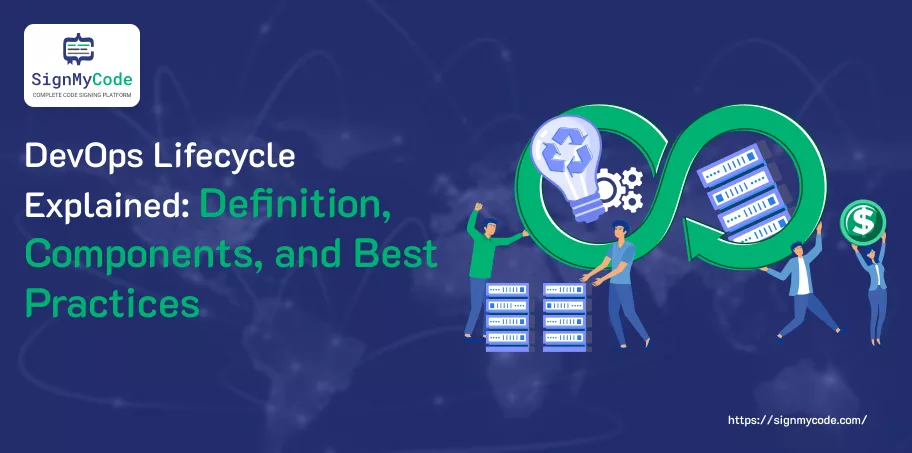DevOps Lifecycle Explained: Definition, Phases, Components, and Best Practices

With constant developments being made in the area of software development, both development and operations teams are now inseparably tied in their processes, and this has become a vital factor for their success.
In recent years, DevOps, a concept built from the words’ developer’ and ‘operator,’ was developed as a new way of working that intelligently integrates these two essential functions throughout the software delivery process.
To cut the crust, DevOps acts to make the software development process smooth by integrating and automating all lifecycle stages, thereby devising a culture of continuous Integrated, Delivered, and improvement.
This is a holistic guide that unravels the DevOps lifecycle, takes it apart from its principal components, and touches the 7Cs, giving success directives and practical procedures that lead to DevOps’ effective implementation and management.
What Is DevOps?
DevOps is a term that specializes in regrouping different software development (Dev) practices with IT operations (Ops) so that they can all get into the same process. It underlines the importance of joining cross-function teams and employing timely and high-quality, agile software development processes.
The key objectives of DevOps involve:
- Expediting the time-to-market for fresh functionality and updates,
- Ensuring software’s quality by way of continuous testing and integration,
- Streamlining the operations process and improving stability through automation.
- Building a culture where development and operations teams jointly take ownership of their responsibilities.
People come to the DevOps life cycle by either considering business agility or facing bottlenecks in traditional IT processes.
Recommended: Top 10 DevOps Trends to Watch Out for in 2024 and Beyond
The DevOps lifecycle is a non-sequential and repetitive process that permits the improvement of the application from planning and coding to further optimization. This lifecycle is usually expressed as a cycle or loop, subtly indicating that DevOps practices are continuous.
The critical components of the DevOps lifecycle include:
Plan and Code:
The process usually begins with ascertaining the customer’s needs and drafting the software architecture.
Build and Integrate:
In the build phase, developers merge their changes into a shared repository. When an automated build kicks in, the app files are compiled, and the package is fully formatted.
Test and Validate:
Checking and validating continue to be done to verify that the software is of high quality and stable.
Deploy and Release:
The app will then finally pass all tests, after which it will be automatically deployed to various environments (e.g., staging and production) before its release.
Monitor and Operate:
The deployed application is fully monitored for performance, security, and user experience. The feedback gathered from users, security preferences, and other sources will feed the next iteration.
The 7Cs as an Overview of the DevOps Lifecycle
The DevOps lifecycle is underpinned by seven fundamental principles, often referred to as the “7Cs” which are essential for successful DevOps implementation and management:
Continuous Integration (CI):
The developer code changes from different developers are hosted in a shared repository where automatic coding and testing are triggered simultaneously. This method is very helpful as it significantly saves additional costs that the company may have to spend when trying to deal with integration problems that may come up during the entire working process.
Continuous Delivery (CD):
This method saves time and makes software updates possible without loss or safety by delivering updates to production or other environments. Developers always have the software ready for further deployment, which is a good approach to solving the problem of releases as it minimizes stress and effort.
Continuous Testing:
Testing automation is one of the critical elements of the DevOps model, guaranteeing software quality and reliable application operation. Checks are conducted constantly, from active code testing to joint tests and end-to-end tests.
Continuous Monitoring:
Effective observability of applications and infrastructure must be implemented for early detection of issues and possible resolutions. Monitoring tools give deep insight into application performance, system health, and user experience, thereby enabling quick reactions and preventing the collapse of these elements.
Continuous Feedback:
Feedback processes are put in place to collect perspectives from different components, such as development teams, operative teams, and end users. Such feedback contributes to continuous development and builds a bridge connecting the business plans and goals.
Continuous Deployment:
The unified deployment of software updates to production environments through machine automation without human intervention. The release process is a constant deployment that ensures iterative blocks of new features and bug fixes reach the final users as accordingly and flawlessly as possible.
Continuous Improvement:
DevOps is a cultural construct of steady improvement and perpetual modification geared towards integrating and improving tools and ways of working. Teams’ workflows, tools, and methodologies are constantly revised over time, and they look for opportunities to enhance their efficiency and effectiveness.
Top Practices for DevOps Implementations and Processes
For a smooth transition and maintenance of DevOps in the core business operations, several proven procedures should be adopted, which, among other things, fit the DevOps concepts and goals.
Here are some essential best practices to consider:
Foster a DevOps Culture:
Being DevOps-oriented is crucial for the success of any implementation. First, it calls for leaders to collapse the chain of traditional duplicates, create a collaborative system and shared responsibility across teams, and, finally, create an atmosphere of continuous improvement.
Automate Everything:
Automation is an underlying tool for DevOps that delivers effective and repeatable processes towards the set goals. Apply automation to builds, testings, and deployments, create infrastructure, and make monitoring.
Recommended: Code Signing for Secure DevOps and DevSecOps: Centralized Management and Automation
Implement CI/CD Pipeline:
Set up a robust Continuous Integration/Continuous Delivery (CI/CD) pipeline that removes manual steps from the software deployment process. The pipeline automates and executes the build, test, and production stages. Thus, the software rolls out in real time and is secure.
Adopt Agile Methodologies:
Adopt agile process principles such as iterative Development, cross-functional teams, and feedback loops. Agile methodologies integrate and respond smoothly with DevOps principles, permitting frequent adaptation to new needs and cooperation between cross-functional teams.
Implement Infrastructure as Code (IaC):
You can handle and assign infrastructure resources using code. This allows you to have a number of applied deployments that are steady and repeated. IaC helps ensure the scalability of infrastructure, more straightforward maintenance, and the creation of a way to have version control.
Embrace Microservices Architecture:
Microservices-based architecture must be deployed to make it scalable, resilient, and flexible. Microservices split the large application into many smaller services that function independently, guaranteeing shorter development times and painless good performance.
Leverage Cloud and Containerization:
Deploy a cloud-computing-based system and exploit containerization technologies for scalability, portability, and resource efficiency aspects. Containers simplify the process of creating consistent application configurations and deployments independent of their environments.
Recommended: Code Sign With Azure DevOps Using a Code Signing Certificate Stored Within Azure Key Vault
Implement Comprehensive Monitoring and Logging:
Incorporate a holistic monitoring and logging tool to enhance visibility about application and infrastructure performances. The fact that robust monitoring and logging facilitate early defect detection, bug-solving, and data-driven management stems from this.
Conclusion:
For organizations to successfully meet their business goals, they need to give top priority to the 7Cs, which include the following, and adopt best practices that will bring faster time to market, higher software quality, and enhanced operational efficiency.
Simply implementing DevOps is nothing more than standard and technical change; instead, it requires a cultural revolution through which teamwork, automation, and continuous improvement will thrive. By practicing DevOps with appropriate tools and techniques, companies can perform much better in the changing world of complex technologies being continuously created.
Remember, the DevOps journey is a continuous process of learning, adapting, and refining. Embrace the mindset of constant improvement, and your organization will be well-equipped to deliver exceptional software experiences to your customers while maintaining a competitive edge in the market.
Frequently Asked Questions:
How is Agile different from DevOps, and is it better?
Succession principles in DevOps and Agile, such as iterative Development and collaboration, are the same, but these two are separate ideas.
Agile stands for the mindset of software development methodologies, while DevOps is focused on integrating development and operations processes during the software delivery lifecycle.
Can small and medium-sized companies use DevOps, too?
Yes, DevOps methods will work for small businesses and grand corporations, including startups and multiple national companies. These principles of collaboration, automation, and continuous improvement are practically applied and can help software delivery processes maintain good order in any organization.
What processes are used by DevOps to ensure secure software delivery?
The DevOps approach, referred to as DevSecOps, links security practice distribution across the continuous software development process. These security measures are also meant to include automated security testing, scanning for vulnerabilities, and secure coding right through the phases of planning and saving code.
Which are the most used ones in a DevOps toolkit?
The particular DevOps toolchain could differ from one organization to another depending on the features and applications they may want to acquire. Nevertheless, git, Jenkins, docker, Kubernetes, Ansible, or Terraform represent the tools that are often used.
How can human collaboration be improved for the DevOps part of all teams involved in Development and operational teams?
DevOps imposes a common shared responsibility and joint accountability between the dept of Development and that of Operations. Promoting teamwork between the two departments through eras of traditional silos and fostering the spirit of cross-collaboration, DevOps helps the two teams to work together and come up with a mutual objective of deploying high-quality software within the least amount of time.


